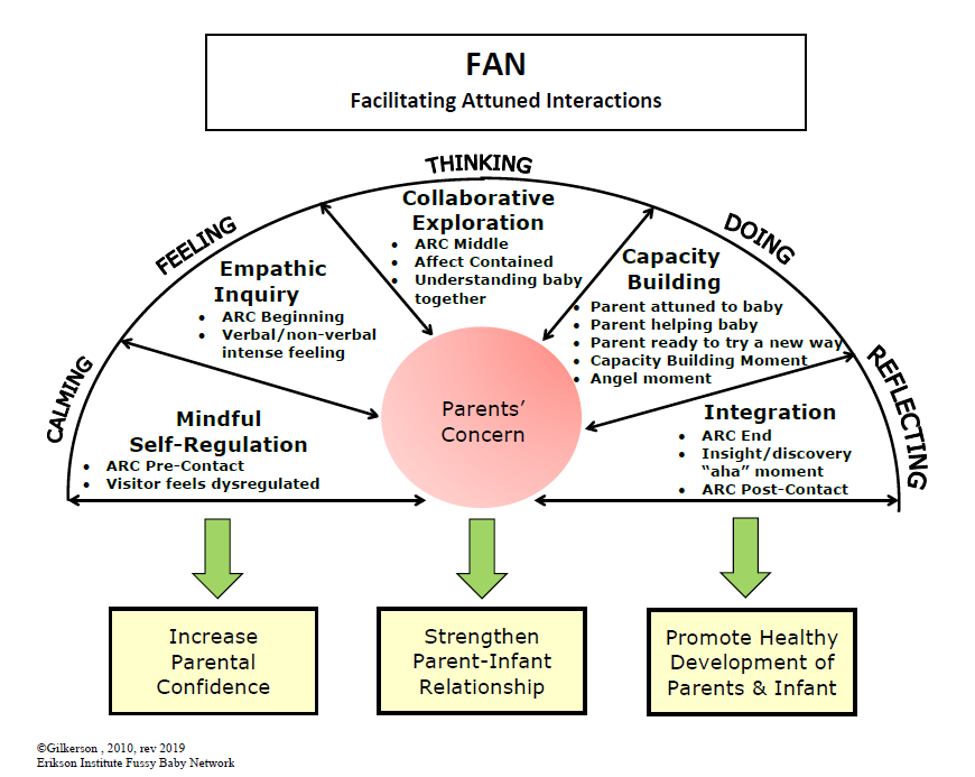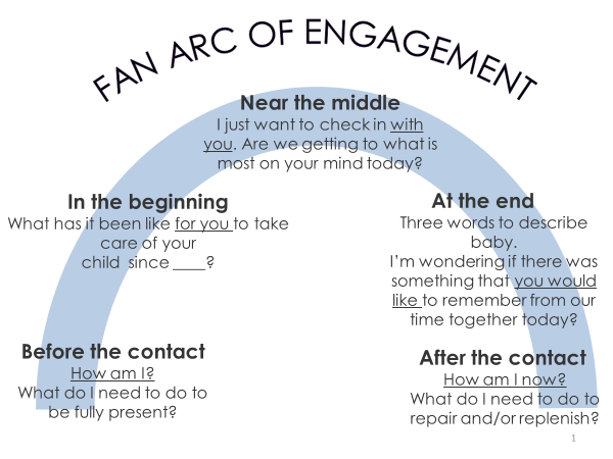A New Promising Practice for Building Relationships and Reflective Practice in Oregon
Linda Gilkerson, PhD
Professor
Erikson Institute
Kerry Cassidy Norton, MPH
Home Visiting Workforce Development Coordinator
Oregon Health Authority
Within the past decade, home visiting programs for infants, young children, and families have greatly expanded. In 2018 alone, 286,108 families and 312,635 children received support through home visiting programs in the United States.1 This level of growth requires a skilled and supported workforce ready to address the complex challenges that families who are served experience. Home visiting is a relationship-based service where professionals work with families to support their health and well-being, and assist them in achieving family goals. Often, home visitors help families experiencing intimate partner violence, substance use disorders, and mental health challenges. Home visitors may also have a history of adverse child experiences (ACEs). For example, 81 percent of home visitors in Region X reported at least one ACE, and 33 percent reported having experienced four or more.2 Those with this history are at risk of secondary trauma and burnout, which requires systems to have additional capacity building as well as support for home visitors.
There are strategies that home visitors can use to build strong relationships with families and sustain their own well-being while doing the work. To address this need, the Oregon Maternal Infant and Early Childhood Home Visiting (MIECHV) program participated in the Region X Innovation Grant, which was funded by the Health Resources and Services Administration, along with MIECHV programs in Alaska, Idaho and Washington. This workforce development grant delivered a new home visiting approach to Oregon. This practice, called FAN (Facilitating Attuned Interactions), is a conceptual model and practical tool for relationship building and reflective practice, which can be used regardless of the model of home visiting used and has been demonstrated to reduce burnout and increase reflective capacity in home visitors.3 The theory of change underlying the FAN approach is attunement, defined as engaging with a person so they feel connected and understood which opens the space for change. FAN teaches providers to be as adept at reading adult cues as they are at reading baby cues. Providers learn to observe parents, match interactions to what the parents are most able to use in the moment and respond flexibly to meet them where they are.
To do this, the FAN identifies five processes for attuned communication: Calming, Feeling, Thinking, Doing, and Reflecting, as demonstrated in the graphic below. The model itself can be used in a range of settings across many disciplines, as will be discussed later in this article.

The first process of FAN is “Calming or Mindful Self-Regulation is unique in that it focuses on the provider’s self-awareness. Providers learn to notice, track and regulate their own reactions to stay present for the family. Providers accomplish this by learning to use Mindful Self-Regulation strategies, such as breathing, grounding, or self-talk so they can see more clearly what is needed in the interaction. The four remaining processes include:
- Feeling or Empathic Inquiry, which entails providing emotional support when parents are expressing feelings.
- Thinking or Collaborative Exploration, which is used when parents want to think together to understand the concern or make a plan.
- Doing or Capacity Building when parents are ready to learn or build skills
- Reflecting or Integration, which validates parents’ insights about their child, their parenting, or their concerns.
Through training and mentoring on the FAN, home visitors learn to identify matches, mismatches, and make repairs in their interactions with parents. A match occurs when the parent and provider are in the same place on the FAN; in other words, the parent is expressing feelings and the provider offers emotional support. The most common mismatch occurs when the parent is in the Feeling process, and the provider has moved too quickly to the Doing process, giving information or advice that the parent cannot take in or use. A repair might look like this: “I think I jumped too fast with my ideas. I’d really like to hear what you feel is happening.”

The FAN ARC of Engagement provides a predictable structure for the provider and parent encounter. The structure has a clearly defined beginning, middle check-in, and end intentionally designed to promote collaboration with the parent throughout the contact. In addition, the ARC includes a pre-visit and post-visit reflection for the provider.
When Region X conducted an evaluation, it became clear that “the FAN’s focus on shifting the role of the home visitor from one of ‘fixer’ to one of empathetic listener was highlighted as the most fundamentally important component of the FAN approach. Home visitors saw this as ‘game-changing’ in their practice.”4 Across disciplines including medicine, FAN trained professionals report being more empathic, more collaborative, and more satisfied in their roles.5,6 Oregon found the FAN to be a tangible way for home visitors to be trauma-informed in family visits. The FAN is implemented in 20 out of Oregon’s 36 counties, including Title V communities focusing on ACEs, trauma, and resiliency, in both community-based and public health department settings. Additional trainings are planned for 2020 to continue to bring these efforts to scale and better meet the needs of all Oregon families.
Although the FAN was originally developed in Chicago Erikson Institute’s Fussy Baby Network in 2010, more than 20 states use this model in a range of settings, including home visiting, primary care, early intervention, mental health and child welfare FAN is also being integrated into two national evidence-based home visiting models, Healthy Families America and Nurse-Family Partnership. It is designated as a promising practice in AMCHP’s Innovation Station. To learn more about FAN training, please contact Tori Graham.
References
- National Home Visiting Resource Center. (2019). 2019 Home visiting yearbook. Arlington, VA: James Bell Associates and the Urban Institute.
- Schaack, D., Molieri, A., Franko, M., Roberts, A., Wacker, A., Estrada, M., & Gann, H. (2019). The Region X home visiting workforce study: Brief 1. Denver, CO: Butler Institute for Families, Graduate School of Social Work, University of Denver.
- Spielberger, J. Burkhardt, T., Winje, C., & Gouvea, M. (2017). Impact of FAN training on home visitors over time (waves 3,4,5). Chicago, IL: Chapin Hall at the University of Chicago.
- Green, B. L., Nygren, P., Burton, M. & Gordon, A. (June 2019). Maternal, Infant, and Early Childhood Home Visiting (MIECHV) Region X workforce innovation grant evaluation, Executive Summary, pp. viii. Portland State University, Portland, OR. Report submitted to Washington, Department of Children Youth and Families.
- Cosgrove, K., Gilkerson, L., Leviton, A., Mueller, M., Norris-Shortle, C., & Gouvea, M. (2019). Building professional capacity to strengthen parent/professional relationships in early intervention: The FAN approach. Infants & Young Children. 32: 4, 245–254.
- Gilkerson, L., Gray, L., Barnes, M., Osta, A., Pryce, J., & Justice, R. (2017). Increasing pediatrician empathy in communication with parents. Austin, TX: Poster presentation at the Society for Research on Child Development.
